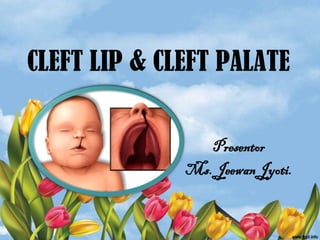
Care for Children with Cleft Lip and Palate
- 1. CLEFT LIP & CLEFT PALATE Presentor Ms. Jeewan Jyoti.
- 2. OBJECTIVES At the end of the teaching students will be able to acquire the knowledeg regarding the cleft lip and cleft palate and will be able to provide care to the children suffering from the cleft lip and cleft palate.
- 3. INTRODUCTION Cleft is a fissure or opening – a gap It is the non-fusion of the body’s natural structures that form before birth Cleft lip (cheiloschisis) and cleft palate (palatoschisis) are birth defects, that affect the upper lip and roof of the mouth, in which there is an opening in the lip and/or palate that is caused by incomplete development during early fetal formation
- 4. DEFINITION Cleft Lip (Cheiloschisis): “ It is defined as a congenital anomaly in which there is presence of a fissure at upper lip which occurs due to failure of fusion of the maxillary and median nasal processes” Cleft Palate (Palatoschisis): “It is defined as a congenital anomaly in which there is a fissure at roof of the mouth which occurs due to failure of fusion of the lateral palatine processes, the nasal septum and the median palatine processes.”
- 5. INCIDENCE RATE 1 in 665 children Cleft lip in Cleft palate in
- 6. CAUSES • Genetic factor • Maternal factors • Environmental factors • Teratogenic drugs • Family history
- 7. TYPES OF CLEFT LIP & CLEFT PALATE Cleft lip without a cleft palate Cleft palate without a cleft lip Cleft lip and cleft palate together
- 9. Cont……. • Partial or incomplete cleft • Complete cleft *Unilateral complete cleft * Bilateral complete cleft
- 11. PATHOPHYSIOLOGY • The embryological development of the upper lip and nose involves fusion of the 5 major facial prominences, occurring between the 3rd and 8th week of gestation, with lip development between the 3rd and 7th weeks, and palate development between the 5th and 12th weeks. • A cleft lip is formed when normal development is interrupted before 7th week of gestation. The degree of clefting can vary • Deformational cleft lip is seen when failure of fusion of the maxillary and median nasal processes occurs manifested in the form of a fissure in the lip
- 12. PATHOPHYSIOLOGY • Isolated cleft palate: the development of the palate involves fusion of the lateral palatal shelves and nasal septum in an anteroposterior direction from the incisive foramen to the uvula between the 5th and 12th weeks of gestation • A cleft palate is formed when normal palatal development is interrupted before the 12th week of gestation. The degree of clefting can range from a complete isolated cleft palate to a bifid uvula. • Deformational cleft palate is seen in Pierre Robin sequence, where a small mandible (micrognathia) limits the space for the tongue, and the prominent tongue (glossoptosis) mechanically obstructs palatal fusion, leading to the classic triad of micrognathia, glossoptosis, and an isolated cleft palate.
- 13. SIGN AND SYMPTOMS • Feeding problems • Failure to gain weight • Flow of milk through nasal passages during feeding • Poor growth • Repeated ear infections • Speech difficulties • Dental Abnormalities • Speech Difficulties • Middle Ear Fluid Buildup and Hearing Loss
- 14. INVESTIGATION • Prenatal diagnosis • Initial assessment
- 15. MANAGEMENT
- 16. MEDICAL MANAGEMENT • Assessment of the child • Reassurance to parents • Feeding the child • Airway clearance • Infection prevention
- 17. SURGICAL MANAGEMENT • Chieloplasty • Platatoplasty
- 19. Nursing Assessment • Carefully perform the head to toe assessment of the child immediately after the birth • Assess the location and extent of the defect by using gloved finger. • Assess the feeding pattern of the child. • Assess the need for the surgical correction. • Assess the parents understanding of the defect and the need for the surgery.
- 20. NURSING DIAGNOSIS • Altered nutrition less than body requirements • Risk for infection. • Risk for aspiration • Ineffective breathing pattern. • Altered family process • Impaired tissue integrity
- 21. PREOPERATIVE NURSING MANAGEMENT • Feeding the child: steril breast feed, appropriate nipple, burp. • Provide right position • Airway clearance • Reassurance to parents. • Hygienic care • Timings – Follow “rule of ten” for surgery • Immunization – complete all immunization accordingly before surgery. • Thumb sucking – discourage thumb sucking and prevent it. • Encourage the child to lie on its back for practice regarding post-operative positioning. • Monitor the nutritional status of the child.
- 22. POST OPERATIVE NURSING MANAGEMENT • Assess vital signs of child regularly • Reposition the infant every 2 hourly • Clean the suture line with the saline solution and a cotton tipped applicator • Anticipate the child’s need to decrease his crying • Give general post-operative care to the child • Provide side-lying position to drain secretions and prevent aspiration • Protection of surgical sutured • Provide supine position • Maintain protective device on sutures • Provide elbow restrain • Assess the child for irritability, loss of appetite and restlessness every 2 hrs of the surgery • Maintain aseptic dressing with precautions • Avoid injury to mouth of the child • Feeding with medicine dropper • Parental counseling is an important thing and advise about care, feeding and follow up etc
- 23. COMPLICATIONS • Feeding problems • Ear infections and hearing loss • Speech and language delay • Dental problems
- 24. SUMMARIZATION • Definition • Etiology • Classification • Pathophysiology • Clinical manifestation • Diagnostic evaluation • Management
